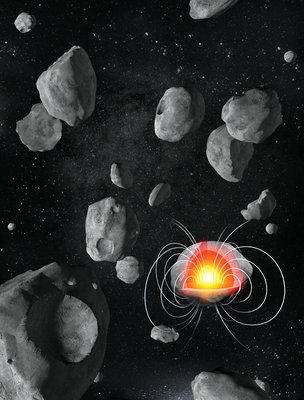
by Erin Wayman Thursday, January 5, 2012

New research suggests that some of the small rocky bodies that smashed together to form planets, called planetesimals, had magnetic fields. Damir Gamulin, courtesy of Benjamin Weiss
Even before the birth of the planets, our solar system was hardly a lonely place. Small rocky bodies, called planetesimals, filled the inner solar system, eventually colliding together to form the planets. Now a new look at a group of ancient meteorites shows that at least some planetesimals generated their own magnetic fields — a feat many scientists thought extremely difficult for such small astronomical bodies. The work also has scientists rethinking how planets formed.
Most meteorites don’t make it to Earth unscathed. After repeatedly smashing into other objects and traveling through Earth’s harsh atmosphere, they can be substantially altered before crash-landing on the planet. But not angrites — a group of 12 stony meteorites that, at an age of about 4.56 billion years old, are among the oldest-known rocks in the solar system and somehow “got here without being messed up,” says Benjamin Weiss, a planetary geologist at MIT in Cambridge, Mass. Because these meteorites are pristine, angrites retain information about the larger body from which they came.
Angrites are also interesting because they are made of basalt. On Earth, basalt forms from magma derived from the mantle. Scientists think angrites similarly erupted from the interior of a planetesimal, Weiss says. This similarity suggests that the planetesimal was likely structured with different layers — crust, mantle, core — just like Earth, he says, rather than being a homogenous chunk of rock, as scientists had thought was the case for most planetesimals.
Weiss and his colleagues tested the magnetism of three angrite samples to learn more about their hosts’ structures. The meteorites retain remnants of a past magnetic field that existed for several million years on their parent planetesimal and had a strength of 10 microteslas, or about 20 percent the strength of Earth’s magnetic field, the team reported in Science. Because of the strength of the field and the angrites’ age and condition, the team ruled out several possible explanations of the magnetism, including magnetic fields caused by solar flares or impacts with other objects. That left one possibility: The planetesimal generated its own magnetic field.
Earth generates a magnetic field — which shields the planet from damaging solar storms — through convection within its liquid iron outer core in a process known as a dynamo. Weiss says that’s probably how the planetesimal generated its magnetic field too. The fact that a planetesimal had a dynamo confirms the fact that it was layered, he says, and shows that its core was metallic.
“It’s absolutely fascinating to start thinking about dynamos so early in the solar system,” says Mike Fuller, a senior researcher at the Hawaii Institute of Geophysics and Planetology at the University of Hawaii at Mãnoa. And the fact that such a small object, probably just 160 kilometers across, or about the distance between Philadelphia and New York City, produced an Earth-like dynamo is unexpected, adds Sean Solomon, director of the Department of Terrestrial Magnetism at the Carnegie Institution of Washington in Washington, D.C. “These asteroid-[like objects] were behaving more like mini-planets than we realized.”
Weiss wants to get a better idea of how many planetesimals were differentiated and generating magnetic fields by looking for other unblemished meteorites that he can test. If the planetesimals that crashed and piled together to create the planets were layered — not homogenous — then scientists should rethink the earliest years of a planet’s history and reconsider the processes that led to a planet’s composition and structure, Weiss says.
And the fact that at least one planetesimal was capable of generating a magnetic field, Solomon says, “forces us to rethink everything these small bodies were doing.”
© 2008-2021. All rights reserved. Any copying, redistribution or retransmission of any of the contents of this service without the expressed written permission of the American Geosciences Institute is expressly prohibited. Click here for all copyright requests.